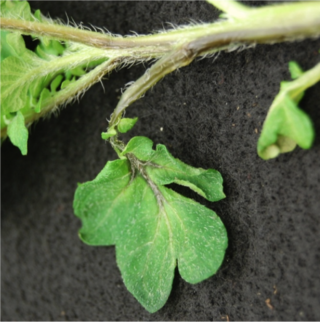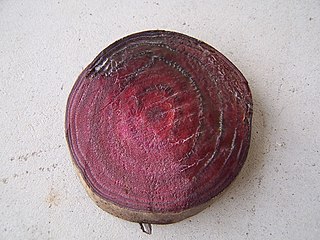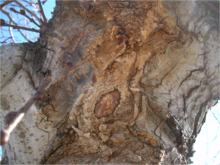Blight is a specific symptom affecting plants in response to infection by a pathogenic organism.

Fire blight, also written fireblight, is a contagious disease affecting apples, pears, and some other members of the family Rosaceae. It is a serious concern to apple and pear producers. Under optimal conditions, it can destroy an entire orchard in a single growing season.

Enterobacterales is an order of Gram-negative, non-spore forming, facultatively anaerobic, rod-shaped bacteria with the class Gammaproteobacteria. The type genus of this order is Enterobacter.

Erwinia is a genus of Enterobacterales bacteria containing mostly plant pathogenic species which was named for the famous plant pathologist, Erwin Frink Smith. It contains Gram-negative bacteria related to Escherichia coli, Shigella, Salmonella, and Yersinia. They are primarily rod-shaped bacteria.

Cystovirus is a genus of double-stranded RNA viruses which infects bacteria. It is the only genus in the family Cystoviridae. The name of the group cysto derives from Greek kystis which means bladder or sack. There are seven species in this genus.

Asparaginase is an enzyme that is used as a medication and in food manufacturing. As a medication, L-asparaginase is used to treat acute lymphoblastic leukemia (ALL) and lymphoblastic lymphoma (LBL). It is given by injection into a vein, muscle, or under the skin. A pegylated version is also available. In food manufacturing it is used to decrease acrylamide.

Dickeya dadantii is a gram-negative bacillus that belongs to the family Pectobacteriaceae. It was formerly known as Erwinia chrysanthemi but was reassigned as Dickeya dadantii in 2005. Members of this family are facultative anaerobes, able to ferment sugars to lactic acid, have nitrate reductase, but lack oxidases. Even though many clinical pathogens are part of the order Enterobacterales, most members of this family are plant pathogens. D. dadantii is a motile, nonsporing, straight rod-shaped cell with rounded ends, much like the other members of the genus, Dickeya. Cells range in size from 0.8 to 3.2 μm by 0.5 to 0.8 μm and are surrounded by numerous flagella (peritrichous).
The pelB leader sequence is a sequence of amino acids which, when attached to a protein, directs the protein to the bacterial periplasm, where the sequence is removed by a signal peptidase. Specifically, pelB refers to pectate lyase B of Erwinia carotovora CE. The leader sequence consists of the 22 N-terminal amino acid residues. This leader sequence can be attached to any other protein resulting in a transfer of such a fused protein to the periplasmic space of Gram-negative bacteria, such as Escherichia coli, often used in genetic engineering. Protein secretion can increase the stability of cloned gene products. For instance it was shown that the half-life of the recombinant proinsulin is increased 10-fold when the protein is secreted to the periplasmic space.

Pantoea is a genus of Gram-negative bacteria of the family Erwiniaceae, recently separated from the genus Enterobacter. This genus includes at least 20 species. Pantoea bacteria are yellow pigmented, ferment lactose, are motile, and form mucoid colonies. Some species show quorum sensing ability that could drive different gene expression, hence controlling certain physiological activities. Levan polysaccharide produced by Pantoea agglomerans ZMR7 was reported to decrease the viability of rhabdomyosarcoma (RD) and breast cancer (MDA) cells compared with untreated cancer cells. In addition, it has high antiparasitic activity against the promastigote of Leishmania tropica.

Pectobacterium carotovorum is a bacterium of the family Pectobacteriaceae; it used to be a member of the genus Erwinia.

Bacterial wilt is a complex of diseases that occur in plants such as Cucurbitaceae and Solanaceae and are caused by the pathogens Erwinia tracheiphila, a gram-negative bacterium, or Curtobacterium flaccumfaciens pv. flaccumfaciens, a gram-positive bacterium. Cucumber and melon plants are most susceptible, but squash, pumpkins, and gourds may also become infected.

Bacterial soft rots are caused by several types of bacteria, but most commonly by species of gram-negative bacteria, Erwinia, Pectobacterium, and Pseudomonas. It is a destructive disease of fruits, vegetables, and ornamentals found worldwide, and affects genera from nearly all the plant families. The bacteria mainly attack the fleshy storage organs of their hosts, but they also affect succulent buds, stems, and petiole tissues. With the aid of special enzymes, the plant is turned into a liquid mush in order for the bacteria to consume the plant cell's nutrients. Disease spread can be caused by simple physical interaction between infected and healthy tissues during storage or transit. The disease can also be spread by insects. Control of the disease is not always very effective, but sanitary practices in production, storing, and processing are something that can be done in order to slow the spread of the disease and protect yields.
Dickeya is a genus of the family Pectobacteriaceae that consists mainly of pathogens from herbaceous plants. Dickeya is the result of the reclassification of 75 strains of Pectobacterium chrysanthemi, as well as Brenneria paradisiaca CFBP 4178, into a new genus. The genus is named for American phytopathologist Robert S. Dickey. Several species in this genus, such as Dickeya dadantii, are known phytopathogens.

Pectobacterium atrosepticum is a species of bacterium. It is a plant pathogen causing blackleg of potato. Its type strain is CFBP 1526T. Its genome has been sequenced.
Erwinia pyrifoliae is a Gram-negative bacterium and a phytopathogen of Asian pear trees, causing necrotic disease. Its type strain is Ep16/96T(=CFBP 4172T =DSM 12163T.

Beet vascular necrosis and rot is a soft rot disease caused by the bacterium Pectobacterium carotovorum subsp. betavasculorum, which has also been known as Pectobacterium betavasculorum and Erwinia carotovora subsp. betavasculorum. It was classified in the genus Erwinia until genetic evidence suggested that it belongs to its own group; however, the name Erwinia is still in use. As such, the disease is sometimes called Erwinia rot today. It is a very destructive disease that has been reported across the United States as well as in Egypt. Symptoms include wilting and black streaks on the leaves and petioles. It is usually not fatal to the plant, but in severe cases the beets will become hollowed and unmarketable. The bacteria is a generalist species which rots beets and other plants by secreting digestive enzymes that break down the cell wall and parenchyma tissues. The bacteria thrive in warm and wet conditions, but cannot survive long in fallow soil. However, it is able to persist for long periods of time in the rhizosphere of weeds and non-host crops. While it is difficult to eradicate, there are cultural practices that can be used to control the spread of the disease, such as avoiding injury to the plants and reducing or eliminating application of nitrogen fertilizer.

Blackleg is a plant disease of potato caused by pectolytic bacteria that can result in stunting, wilting, chlorosis of leaves, necrosis of several tissues, a decline in yield, and at times the death of the potato plant. The term "blackleg" originates from the typical blackening and decay of the lower stem portion, or "leg", of the plant.
Robert S. Dickey was an American phytopathologist, professor emeritus of Plant Pathology at the Cornell University and the namesake of the bacterial genus Dickeya.
Soft rot Enterobacteriaceae (SRE), are ubiquitous necrotrophic bacterial pathogens that infect a large number of different plant species worldwide, including economically important crops.

The Erwiniaceae are a family of Gram-negative bacteria which includes a number of plant pathogens and insect endosymbionts. This family is a member of the order Enterobacterales in the class Gammaproteobacteria of the phylum Pseudomonadota. The type genus of this family is Erwinia.













